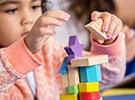Symmetry Game
In this lesson, children will pair up and use pattern blocks to copy one another's patterns.
Lesson for:
Toddlers/Preschoolers
(See Step 5: Adapt lesson for toddlers or preschoolers.)
Content Area:
Geometry
Learning Goals:
This lesson will help toddlers and preschoolers meet the following educational standards:
- Apply transformations and use symmetry to analyze mathematical situations
- Use visualization, spatial reasoning and geometric modeling to solve problems
Learning Targets:
After this lesson, toddlers and preschoolers should be more proficient at:
- Recognizing and creating shapes that have symmetry
- Recognizing and applying slides, flips and turns
- Creating mental images of geometric shapes, using spatial memory and spatial visualization
- Recognizing and representing shapes from different perspectives
- Recognizing geometric shapes and structures in the environment and specifying their locations

Symmetry Game
Lesson plan for toddlers/preschoolers
Step 1: Gather materials.
- A mat, divided in half with a clear line (line of symmetry) distinguishing the divider
- Pattern blocks
Note: Small parts pose a choking hazard and are not appropriate for children age five or under. Be sure to choose lesson materials that meet safety requirements.
Step 2: Introduce activity.
- Show the pattern block symmetry pictures to the children. Ask them what they notice about the pictures. Fold the pictures down the line of symmetry and again ask the children what they notice about the pictures.
- Explain the concept of symmetry to the children (the two sides of the whole are exactly like one another) and explain that today they are going to use pattern blocks to play The Symmetry Game.
Step 3: Engage children in lesson activities.
- Demonstrate how to play the game, which is played in pairs, and choose a child to play the game with you.
- Give the partners one mat. The first player puts down one pattern block. The pattern block should touch the line of symmetry. The second player copies by placing the same block in the same place, but on the other side of the line of symmetry.
- Continue the game until both players have used five or six blocks apiece. Point out that the designs they have made are symmetrical. Explain that the design is symmetrical because each side of the line has blocks of the same color in the same place.
- Remove the blocks and repeat the game. This time, the second player starts the game.
Additional Extensions
- Point out real things in your classroom that are symmetrical. Show them to the children and ask: “Is this (object) symmetrical? Why or why not?”
- Create simple symmetrical pictures, as well as some pictures that are not symmetrical. Ask: “Which of these pictures are symmetrical and which of these pictures are not?” Have the children explain their thinking.
Step 4: Vocabulary.
- Symmetrical: The two sides of the whole are exactly like one another (e.g.,”Is the tiger’s face exactly the same on this side of our invisible line as it is on the other side of our line? If so, the tiger’s face is symmetrical.”)
- Same: Identical in kind or quantity (e.g.,”The design is symmetrical because each side of the line has blocks of the same color and in the same place.”)
- Line of Symmetry: Divides an object or design in half, so that both sides are the same (e.g.,”The second player copies by placing the same block in the same place, but on the other side of the line of symmetry.”)
Step 5: Adapt lesson for toddlers or preschoolers.
Adapt Lesson for Toddlers
Toddlers may:
- Need some assistance in recognizing the various details of their photos, so that they can better duplicate those details in their mirrored drawings
- Need to see some additional examples of symmetry
Child care providers may:
- Start the game with two pattern blocks and increase the blocks as the children’s understanding of symmetry grows
- Help point out the symmetrical objects within the photo. “You have an eye on this side of your face. Will you need an eye on the other side of your face? Where should that eye go?”
- Continue to point out the symmetry in objects around the room or in books
Adapt Lesson for Preschoolers
Preschoolers may:
- Grasp the concept of symmetry and look for additional ways to extend their knowledge
Child care providers may:
- Have the children go on a “symmetry hunt” around the room, identify symmetrical objects and draw these objects in a notebook. Children should have a math journal readily available to record their mathematical thinking, reasoning and observations. Share their findings. Make a classroom chart of symmetrical objects in the room.
Suggested Books
- Seeing Symmetry by Loren Leedy (New York: Holiday House, 2012)
- What is Symmetry in Nature? by Bobbie Kalman (New York: Crabtree Pub Co., 2010)
- It Looked Like Spilt Milk by Charles G. Shaw (New York: Haperfestival, 1992)
Music and Movement
Outdoor Connections
- Go on a “symmetry hunt” outside. Have the children bring their math journals with them so that they can write down or draw all of the symmetrical objects that they notice. If possible, collect some symmetrical objects to bring inside and investigate further.
- Read What is Symmetry in Nature? by Bobbie Kalman. Encourage the children to make connections between what they read in the book and what they see in their outdoor environment.
Comment on this lesson